Augmented Reality in Professional Training: A Review of the Literature from 2001 to 2020
Abstract
1. Introduction
- What are the trends of publications and research types for AR-supported professional training?
- What are the essential technological features and affordances of AR that support professional training, and how are they evolving over time?
- What instructional strategies have been employed in the AR-supported professional training?
- What is the overall effectiveness of AR application in professional training and what are the moderating factors?
2. Methods
2.1. Literature Selection Process
2.1.1. Initial Literature Search
2.1.2. Manual Screening
2.2. The Data Coding and Analysis Processes
3. Results
3.1. Publication Trends
3.2. Instructional Contexts
3.3. Technological Features and Affordances
3.3.1. Input and Output
3.3.2. Computing Devices
3.3.3. Media Representation
3.4. Instructional Design
3.4.1. Pedagogy
3.4.2. Types of Learning Outcomes
3.4.3. Instructional Function and Interactivity
3.5. Meta-Analysis
4. Discussion and Conclusions
4.1. Implications for Practice
4.2. Implications for Future Research
Author Contributions
Funding
Institutional Review Board Statement
Informed Consent Statement
Data Availability Statement
Conflicts of Interest
Appendix A. Research Articles Selected for the Systematic Review
| Author and Year | Article Title | Research Type | Discipline | Doi |
| Gelenbe, E. (2002) | Simulating autonomous agents with augmented reality | Design case | 10.1016/j.jss.2004.01.016 | |
| Weidenbach, M. (2004) | Intelligent training system integrated in an echocardiography simulator | Design case | Health and Medicine | 10.1016/S0010-4825(03)00084-2 |
| Lacey, G. (2007) | Mixed-reality simulation of minimally invasive surgeries | Design case | Health and Medicine | |
| Magee, D. (2007) | An augmented reality simulator for ultrasound guided needle placement training | Empirical research | Health and Medicine | 10.1007/s11517-007-0231-9 |
| Wang, X. (2007) | Design, strategies, and issues towards an Augmented Reality-based construction training platform | Design case | Engineering | |
| Botden, S.M.B.I. (2008) | ProMIS augmented reality training of laparoscopic procedures face validity | Empirical research | Health and Medicine | 10.1097/SIH.0b013e3181659e91 |
| Feifer, A. (2008) | Hybrid Augmented Reality Simulator: Preliminary Construct Validation of Laparoscopic Smoothness in a Urology Residency Program | Empirical research | Health and Medicine | 10.1016/j.juro.2008.06.042 |
| Koehring, A. (2008) | A Framework for Interactive Visualization of Digital Medical Images | Design case | Health and Medicine | 10.1089/lap.2007.0240 |
| Anastassova, M. (2009) | Automotive technicians’ training as a community-of-practice: Implications for the design of an augmented reality teaching aid | Empirical research | Engineering | 10.1016/j.apergo.2008.06.008 |
| Botden, S.M.B.I. (2009) | Suturing training in augmented reality: Gaining proficiency in suturing skills faster | Empirical research | Health and Medicine | 10.1007/s00464-008-0240-2 |
| Harders, M. (2009) | Calibration, registration, and synchronization for high precision augmented reality haptics | Design case | Health and Medicine | 10.1109/TVCG.2008.63 |
| Chimienti, V. (2010) | Guidelines for implementing augmented reality procedures in assisting assembly operations | Design case | Engineering | 10.1007/978-3-642-11598-1_20 |
| Leblanc, F. (2010) | Hand-assisted laparoscopic sigmoid colectomy skills acquisition: Augmented reality simulator versus human cadaver training models | Empirical research | Health and Medicine | 10.1016/j.jsurg.2010.06.004 |
| Phan, V.T. (2010) | Developing outdoor augmented reality for architecture representation in educational activities | Design case | Engineering | |
| Watanuki, K. (2010) | Augmented reality-based training system for metal casting | Design case | Engineering | 10.1007/s12206-009-1175-9 |
| Zhang, J. (2010) | A multi-regional computation scheme in an AR-assisted in situ CNC simulation environment | Design case | Engineering | 10.1016/j.cad.2010.06.007 |
| Behzadan, A. H. (2011) | A colllaborative augmented-reality-based modeling environment for construction enginerring and management education | Design case | Engineering | 10.1109/WSC.2011.6148051 |
| Abhari, K. (2015) | Training for planning tumour resection: Augmented reality and human factors | Empirical research | Health and Medicine | 10.1109/TBME.2014.2385874 |
| Chowriappa, A. (2015) | Augmented-reality-based skills training for robot-assisted urethrovesical anastomosis: A multi-institutional randomised controlled trial | Empirical research | Health and Medicine | 10.1111/bju.12704 |
| Cubillo, J. (2015) | Preparing augmented reality learning content should be easy: UNED ARLE-An authoring tool Empirical research for augmented reality learning environments | Empirical research | Health and Medicine | 10.1002/cae.21650 |
| Espejo-Trung, L.C. (2015) | Development and Application of a New Learning Object for Teaching Operative Dentistry Using Augmented Reality | Empirical research | Health and Medicine | 10.1002/j.0022-0337.2015.79.11.tb06033.x |
| Aivelo, T. (2016) | Digital gaming for evolutionary biology learning: The case study of parasite race, an augmented reality location-based game | Empirical research | Other | 10.31129/LUMAT.4.1.3 |
| Bourdel, N. (2016) | Augmented reality in gynecologic surgery: evaluation of potential benefits for myomectomy in an experimental uterine model | Empirical research | Health and Medicine | 10.1007/s00464-016-4932-8 |
| Chin, K.-Y. (2016) | Development of a mobile augmented reality system to facilitate real-world learning | Empirical research | Other | 10.1007/978-981-10-0539-8_36 |
| Juan, M.-C. (2016) | A mobile augmented reality system for the learning of dental morphology | Empirical research | Health and Medicine | |
| Reyes, A.M. (2016) | A mobile augmented reality system to support machinery operations in scholar environments | Empirical research | Engineering | |
| Díaz-Noguera, M.D. (2017) | Augmented reality applications attitude scale (ARAAS): Diagnosing the attitudes of future teachers | Empirical research | Other | 10.15804/tner.2017.50.4.17 |
| Moro, C. (2017) | The effectiveness of virtual and augmented reality in health sciences and medical anatomy | Empirical research | Health and Medicine | 10.1002/ase.1696 |
| Ozdamli, F. and Bal, E. (2017) | Pre-school teachers’ views about educational materials and augmented reality in preschool education | Empirical research | Other | 10.21506/j.ponte.2017.8.35 |
| Ozdamli, F. and Hursen, C. (2017) | An Emerging Technology: | Empirical research | Engineering | 10.3991/ijet.v12.i11.7354 |
| Augmented Reality to Promote Learning | ||||
| Rochlen, L.R. (2017) | First-Person Point-of-View-Augmented Reality for Central Line Insertion Training: A Usability and Feasibility Study | Empirical research | Health and Medicine | 10.1097/SIH.0000000000000185 |
| Bacca, J. (2018) | Framework for designing motivational augmented reality applications in vocational education and training | Empirical research | Engineering | |
| Huang, C.Y. (2018) | The use of augmented reality glasses in central line simulation: “see one, simulate many, do one competently, and teach everyone” | Empirical research | Health and Medicine | 10.2147/AMEP.S160704 |
| Indrawan, I.W.A. (2018) | Markerless augmented reality utilizing Gyroscope to Demonstrate the Position of Dewata Nawa Sanga | Empirical research | Other | 10.3991/ijim.v12i1.7527 |
| Lee, D. (2018) | Augmented reality to localize individual organ in surgical procedure | Design case | Health and Medicine | 10.4258/hir.2018.24.4.394 |
| Sirakaya, M. (2018) | Effects of augmented reality on student achievement and self-efficacy in vocational education and training | Empirical research | Engineering | 10.13152/IJRVET.5.1.1 |
| Upadhyay, A.K. (2018) | In the age of e-learning: application and impact of augmented reality in training | Theoretical research | Other | 10.1108/DLO-04-2018-0041 |
| Zhu, E. (2018) | Understanding how to improve physicians’ paradigms for prescribing antibiotics by using a conceptual design framework: A qualitative study | Empirical research | Health and Medicine | 10.1186/s12913-018-3657-x |
| Arts, E.E.A. (2019) | Face, Content, and Construct Validity of the Take-Home | Empirical research | Health and Medicine | 10.1089/lap.2019.0070 |
| EoSim Augmented Reality Laparoscopy Simulator | ||||
| for Basic Laparoscopic Tasks | ||||
| Alismail, A. (2019) | Augmented reality glasses improve adherence to evidence-based intubation practice | Empirical research | Health and Medicine | |
| Kascak, J. (2019) | Implementation of Augmented Reality into the Training and Educational Process in Order to Support Spatial Perception in Technical Documentation | Design case | Engineering | 10.1109/IEA.2019.8715120 |
| Lin, C.-H. (2019) | Research into the e-learning model of agriculture technology companies: Analysis by deep learning | Empirical research | Other | 10.3390/agronomy9020083 |
| Tzima, S. (2019) | Augmented reality applications in education: Teachers’ point of view | Empirical research | Other | 10.3390/educsci9020099 |
| Ashely-Welbeck, A. (2020) | Teachers’ perceptions on using Augmented Reality for language learning in Primary Years Programme (PYP) education | Empirical research | Other | 10.3991/ijet.v15i12.13499 |
| Boyaci, M.G. (2020) | Augmented Reality Supported Cervical Transpedicular Fixation on 3D-Printed Vertebrae Model: An Experimental Education Study | Empirical research | Health and Medicine | 10.5137/1019-5149.JTN.30733-20.2 |
| Coelho, G. (2020) | Augmented reality and physical hybrid model simulation for preoperative planning of metopic craniosynostosis surgery | Empirical research | Health and Medicine | 10.3171/2019.12.FOCUS19854 |
| Ingrassia, P.L. (2020) | Augmented reality learning environment for basic life support and defibrillation training: Usability study | Empirical research | Health and Medicine | 10.2196/14910 |
| Kosieradzki, M. (2020) | Applicability of augmented reality in an organ transplantation | Synthesis | Health and Medicine | 10.12659/AOT.923597 |
| Lester, S. (2020) | Some pedagogical observations on using augmented reality in a vocational practicum | Empirical research | Engineering | 10.1111/bjet.12901 |
| Soltani, P. (2020) | Augmented reality tools for sports education and training | Synthesis | Other | 10.1016/j.compedu.2020.103923 |
| Xiao, J. (2020) | Assessing the effectiveness of the augmented reality courseware for starry sky exploration | Empirical research | Other | 10.4018/IJDET.2020010102 |
References
- Azuma, R.T. A Survey of Augmented Reality. Presence Teleoperators Virtual Environ. 1997, 6, 355–385. [Google Scholar] [CrossRef]
- Akçayır, M.; Akçayır, G. Advantages and challenges associated with augmented reality for education: A systematic review of the literature. Educ. Res. Rev. 2017, 20, 1–11. [Google Scholar] [CrossRef]
- Andersson, E.P. Continuing education in Sweden—To what purpose? J. Contin. Educ. Nurs. 2001, 32, 86–93. [Google Scholar] [CrossRef] [PubMed]
- Marin, S. The educational systems and teacher training in the knowledge-based society. Procedia-Soc. Behav. Sci. 2013, 93, 1039–1044. [Google Scholar] [CrossRef][Green Version]
- Flippo, E.B. Personal Management; McGraw-Hill: New York, NY, USA, 1984; p. 192. [Google Scholar]
- Paposa, K.K.; Kumar, Y.M. Impact of training and development practices on job satisfaction: A study on faculty members of technical education institutes. Manag. Labour Stud. 2019, 44, 1–15. [Google Scholar] [CrossRef]
- Davis, D.; O’Brien, M.A.T.; Freemantle, N.; Wolf, F.M.; Mazmanian, P.; Taylor-Vaisey, A. Impact of formal continuing medical education. J. Am. Med. Assoc. 1999, 9, 867–874. [Google Scholar] [CrossRef]
- Korthagen, F.A.J. In search of the essence of a good teacher: Towards a more holistic approach in teacher education. Teach. Teach. Educ. 2004, 20, 77–97. [Google Scholar] [CrossRef]
- Mazmanian, P.E.; Davis, D.A. Continuing medical education and the physician as a learner: Guide to the evidence. J. Am. Med. Assoc. 2002, 9, 1057–1060. [Google Scholar] [CrossRef] [PubMed]
- Anderson, K. Education and training for records professionals. Rec. Manag. J. 2007, 17, 94–106. [Google Scholar] [CrossRef]
- Cheng, E.W.L.; Ho, D.C.K. The influence of job and career attitudes on learning motivation and transfer. Career Dev. Int. 2001, 6, 20–27. [Google Scholar] [CrossRef]
- Truiit, D.L. The effect of training and development on employee attitude as it relates to training and Work Proficiency. SAGE Open 2011, 1, 1–13. [Google Scholar] [CrossRef]
- Bower, M.; Howe, C.; McCredie, N.; Robinson, A.; Grover, D. Augmented reality in education—Cases, places and potentials. Educ. Media Int. 2014, 51, 1–15. [Google Scholar] [CrossRef]
- Abhari, K.; Baxter, J.S.H.; Chen, E.C.S.; Khan, A.R.; Petters, T.M.; de Ribaupierre, S.; Eagleson, R. Training for planning tumour resection: Augmented reality and human factors. IEEE Trans. Biomed. Eng. 2015, 62, 1466–1477. [Google Scholar] [CrossRef]
- Lee, D.Y.; Shin, D.H. An empirical evaluation of multi-media based learning of a procedural task. Comput. Hum. Behav. 2012, 28, 1072–1081. [Google Scholar] [CrossRef]
- Han, X.; Liu, Y.; Li, H.; Fan, Z.; Luo, H. Augmenting the makerspace: Designing collaborative inquiry through augmented reality. In Proceedings of the 2020 International Conference on Blended Learning, Bangkok, Thailand, 24–27 August 2020; Cheung, S., Li, R., Phusavat, K., Paoprasert, N., Kwok, L., Eds.; Springer: Cham, Switzerland, 2020; Volume 12218, pp. 148–159. [Google Scholar]
- Denyer, D.; Tranfield, D. Producing a systematic review. In The Sage Handbook of Organizational Research Methods, 1st ed.; Buchannan, D.A., Bryman, A., Eds.; Sage Publications Ltd.: London, UK, 2009; pp. 671–689. [Google Scholar]
- Serino, M.; Cordrey, K.; McLaughlin, L.; Milanaik, R.L. Poke’mon Go and augmented virtual reality games: A cautionary commentary for parents and pediatricians. Curr. Opin. Pediatr. 2016, 28, 673–677. [Google Scholar] [CrossRef]
- Upadhyay, A.K.; Khandelwal, K. In the age of e-learning: Application and impact of augmented reality in training. Dev. Learn. Organ. Int. J. 2018, 26, 42–45. [Google Scholar] [CrossRef]
- Kosieradzki, M.; Lisik, W.; Gierwiato, R.; Sitnik, R. Applicability of augmented reality in an organ transplantation. Ann. Transplant. 2020, 25, e923597. [Google Scholar] [CrossRef]
- Soltani, P.; Morice, A.H.P. Augmented reality tools for sports education and training. Comput. Educ. 2020, 155, 103923. [Google Scholar] [CrossRef]
- Indrawan, I.W.A.; Bayupati, I.P.A.; Putri, D.P.S. Markerless augmented reality utilizing gyroscope to demonstrate the position of Dewata Nawa Sanga. Int. J. Interact. Mob. Technol. 2018, 12, 19–35. [Google Scholar] [CrossRef]
- Aivelo, T.; Uitto, A. Digital gaming for evolutionary biology learning: The case study of Parasite Race, an augmented reality location based game. LUMAT Int. J. Math Sci. Technol. Educ. 2016, 4, 1–26. [Google Scholar] [CrossRef]
- Tzima, S.; Styliaras, G.; Bassounas, A. Augmented reality applications in education: Teachers point of view. Educ. Sci. 2019, 9, 99. [Google Scholar] [CrossRef]
- Feifer, A.; Delisle, J.; Anidjar, M. Hybrid augmented reality simulator: Preliminary construct validation of laparoscopic smoothness in a urology residency program. J. Urol. 2008, 180, 1455–1459. [Google Scholar] [CrossRef] [PubMed]
- Lacey, G.; Ryan, D.; Cassidy, D.; Young, D. Mixed-reality simulation of minimally invasive surgeries. IEEE MultiMedia 2007, 14, 76–87. [Google Scholar] [CrossRef]
- Weidenbach, M.; Trochim, S.; Kreutter, S.; Richter, C.; Berlage, T.; Grunst, G. Intelligent training system integrated in an echocardiography simulator. Comput. Biol. Med. 2004, 34, 407–425. [Google Scholar] [CrossRef]
- Koehring, A.; Foo, J.L.; Miyano, G.; Lobe, T.; Winer, E. A framework for interactive visualization of digital medical images. J. Laparoendosc. Adv. Surg. Tech. 2008, 18, 697–706. [Google Scholar] [CrossRef] [PubMed]
- Chowriappa, A.; Raza, S.J.; Fazili, A.; Field, E.; Malito, C.; Samarasekera, D.; Shi, Y.; Ahmed, K.; Wilding, G.; Kaouk, J.; et al. Augmented-reality-based skills training for robot-assisted urethrovesical anastomosis: A multi-institutional randomised controlled trial. BJU Int. 2015, 115, 336–345. [Google Scholar] [CrossRef] [PubMed]
- Chin, K.Y.; Lee, K.F.; Hsieh, H.C. Development of a mobile augmented reality system to facilitate real-world learning. In Frontier Computing; Hung, J., Yen, N., Li, K.C., Eds.; Springer: Singapore, 2016; Volume 375, pp. 363–372. [Google Scholar]
- Boyaci, M.G.; Fidan, U.; Yuran, A.F. Augmented reality supported cervical transpedicular fixation on 3D-printed vertebrae model: An experimental education study. Turk. Neurosurg. 2020, 6, 937–943. [Google Scholar] [CrossRef] [PubMed]
- Martín-Gutiérrez, J.; Meneses-Fernández, M.D. Augmented reality environments in learning, communicational and professional contexts in higher education. Digit. Educ. Rev. 2014, 26, 61–73. [Google Scholar]
- Watanuki, K.; Hou, L. Augmented reality-based training system for metal casting. J. Mech. Sci. Technol. 2010, 24, 237–240. [Google Scholar] [CrossRef]
- Phan, V.T.; Choo, S.Y. Developing outdoor augmented reality for architecture representation in educational activities. Int. J. Des. Sci. Technol. 2010, 17, 121–136. [Google Scholar]
- Moro, C.; Stromberga, Z.; Raikos, A.; Stirling, A. The effectiveness of virtual and augmented reality in health sciences and medical anatomy. Anat. Sci. Educ. 2017, 10, 549–559. [Google Scholar] [CrossRef] [PubMed]
- Juan, M.-C.; Alexandrescu, L.; Folguera, F.; García-García, I. A mobile augmented reality system for the learning of dental morphology. Digit. Educ. Rev. 2016, 30, 234–247. [Google Scholar]
- Leblanc, F.; Senagore, A.J.; Ellis, C.N.; Champagne, B.J.; Augestad, K.M.; Neary, P.C.; Delaney, C.P.; Colorectal Surgery Training Group. Hand-Assisted laparoscopic sigmoid colectomy skills acquisition: Augmented reality simulator versus human cadaver training models. J. Surg. Educ. 2010, 67, 200–204. [Google Scholar] [CrossRef]
- Arts, E.E.A.; Leijte, E.; Witteman, B.P.L.; Jakimowicz, J.J.; Verhoeven, B.; Botden, S.M.B.I. Face, content, and construct validity of the Take-Home EoSim augmented reality laparoscopy simulator for basic laparoscopic tasks. J. Laparoendosc. Adv. Surg. Tech. 2019, 29, 1419–1426. [Google Scholar] [CrossRef] [PubMed]
- Lester, S.; Hofmann, J. Some pedagogical observations on using augmented reality in a vocational practicum. Br. J. Educ. Technol. 2020, 51, 645–656. [Google Scholar] [CrossRef]
- Maas, M.J.; Hughes, J.M. Virtual, augmented and mixed reality in K–12 education: A review of the literature. Technol. Pedagog. Educ. 2020, 29, 231–249. [Google Scholar] [CrossRef]
- Frazen, M.M.S. A Study of Trial and Error Learning in Technology, Engineering, and Design Education. Ph.D. Thesis, North Carolina State University, Raleigh, NC, USA, 2016. [Google Scholar]
- Bourdel, N.; Collins, T.; Pizarro, D.; Bartoli, A.; Ines, D.D.; Perreira, B.; Canis, M. Augmented reality in gynecologic surgery: Evaluation of potential benefits for myomectomy in an experimental uterine model. Surg. Endosc. 2016, 31, 456–461. [Google Scholar] [CrossRef]
- Huang, C.Y.; Thomas, J.B.; Alismail, A.; Cohen, A.; Almutairi, W.; Daher, N.S.; Terry, M.H.; Tan, L.D. The use of augmented reality glasses in central line simulation: “See one, simulate many, do one competently, and teach everyone”. Adv. Med. Educ. Pract. 2018, 9, 357–363. [Google Scholar] [CrossRef]
- Kolb, D.A. Experiential Learning: Experience as the Source of Learning and Development; Prentice-Hall: Hoboken, NJ, USA, 1984; p. 41. [Google Scholar]
- Reyes, A.M.; Villegas, O.O.V.; Bojorouez, E.M.; Sanchez, V.G.C.; Nandayapa, M. A Mobile Augmented reality system to support machinery operations in scholar environments. Comput. Appl. Eng. Educ. 2016, 24, 967–981. [Google Scholar] [CrossRef]
- Chimienti, V.; Iliano, S.; Dassisti, M.; Dini, G.; Failli, F. Guidelines for implementing augmented reality procedures in assisting assembly operations. In Proceedings of the Precision Assembly Technologies and Systems, 5th IFIP WG 5.5 International Precision Assembly Seminar, IPAS 2010, Chamonix, France, 14–17 February 2010; Ratchev, S., Ed.; Springer: Berlin/Heidelberg, Germany, 2010; Volume 315, pp. 174–179. [Google Scholar]
- Zhang, J.; Ong, S.K.; Nee, A.Y.C. A multi-regional computation scheme in an AR-assisted in situ CNC simulation environment. Comput.-Aided Des. 2010, 42, 1167–1177. [Google Scholar] [CrossRef]
- Anastassova, M.; Burkhardt, J.-M. Automotive technicians’ training as a community-of-practice: Implications for the design of an augmented reality teaching aid. Appl. Ergon. 2009, 40, 713–721. [Google Scholar] [CrossRef] [PubMed]
- Botden, S.M.B.I.; de Hingh, I.H.J.T.; Jakimowicz, J.J. Suturing training in augmented reality: Gaining proficiency in suturing skills faster. Surg. Endosc. 2009, 23, 2131–2137. [Google Scholar] [CrossRef]
- Cubillo, J.; Martin, S.; Castro, M.; Boticki, I. Preparing augmented reality learning content should be Easy: UNED ARLE—An authoring tool for augmented reality learning environments. Comput. Appl. Eng. Educ. 2015, 23, 778–789. [Google Scholar] [CrossRef]
- Coelho, G.; Rabelo, N.N.; Vieira, E.; Mendes, K.; Figueiredo, E.G. Augmented reality and physical hybrid model simulation for preoperative planning of metopic craniosynostosis surgery. Neurosurg. Focus 2020, 48, E19. [Google Scholar] [CrossRef] [PubMed]
- Sirakaya, M.; Cakmak, E.K. Effects of augmented reality on student achievement and Self-Efficacy in vocational education and training. Int. J. Res. Vocat. Educ. Train. 2018, 5, 1–18. [Google Scholar] [CrossRef]
- Bacca Acosta, J.L.; Navarro, S.B.; Gesa, R.F.; Kinshuk. Insights into the factors influencing student motivation in augmented reality learning experiences in vocational education and training. Front. Psychol. 2018, 9, 1486. [Google Scholar] [CrossRef]
- Ingrassia, P.L.; Mormando, G.; Giudici, E.; Strada, F.; Carfagna, F.; Lamberti, F.; Bottino, A. Augmented Reality Learning Environment for Basic Life Support and Defibrillation Training: Usability Study. J. Med. Internet Res. 2020, 22, e14910. [Google Scholar] [CrossRef]
- Díaz-Noguera, M.D.; Toledo-Morales, P.; Hervás-Gómez, C. Augmented reality applications attitude Scale (ARAAS): Diagnosing the attitudes of future teachers. New Educ. Rev. 2018, 50, 215–226. [Google Scholar]
- Alismail, A.; Thomas, J.; Daher, N.S.; Cohen, A.; Almutairi, W.; Terry, M.H.; Huang, C.; Tan, L.D. Augmented reality glasses improve adherence to evidence-based intubation practice. Adv. Med. Educ. Pract. 2019, 10, 279–286. [Google Scholar] [CrossRef] [PubMed]
- Rochlen, L.R.; Levine, R.; Tait, A.R. First-person point-of-view–augmented reality for central line insertion training. Simul. Healthc. J. Soc. Simul. Healthc. 2017, 12, 57–62. [Google Scholar] [CrossRef]
- Xiao, J.; Cao, M.; Li, X.; Hansen, P. Assessing the effectiveness of the augmented reality courseware for starry sky exploration. Int. J. Distance. Educ. Technol. 2020, 18, 19–35. [Google Scholar] [CrossRef]
- Hedges, L.V. Distribution theory for Glass’s estimator of effect size and related estimators. J. Educ. Stat. 1981, 6, 107–128. [Google Scholar] [CrossRef]
- Israel, H.; Richter, R.R. A guide to understanding meta-Analysis. J. Orthop. Sports Phys. Ther. 2011, 47, 496–504. [Google Scholar] [CrossRef]
- Kraft, M.A. Interpreting effect sizes of education interventions. Educ. Res. 2020, 49, 241–253. [Google Scholar] [CrossRef]
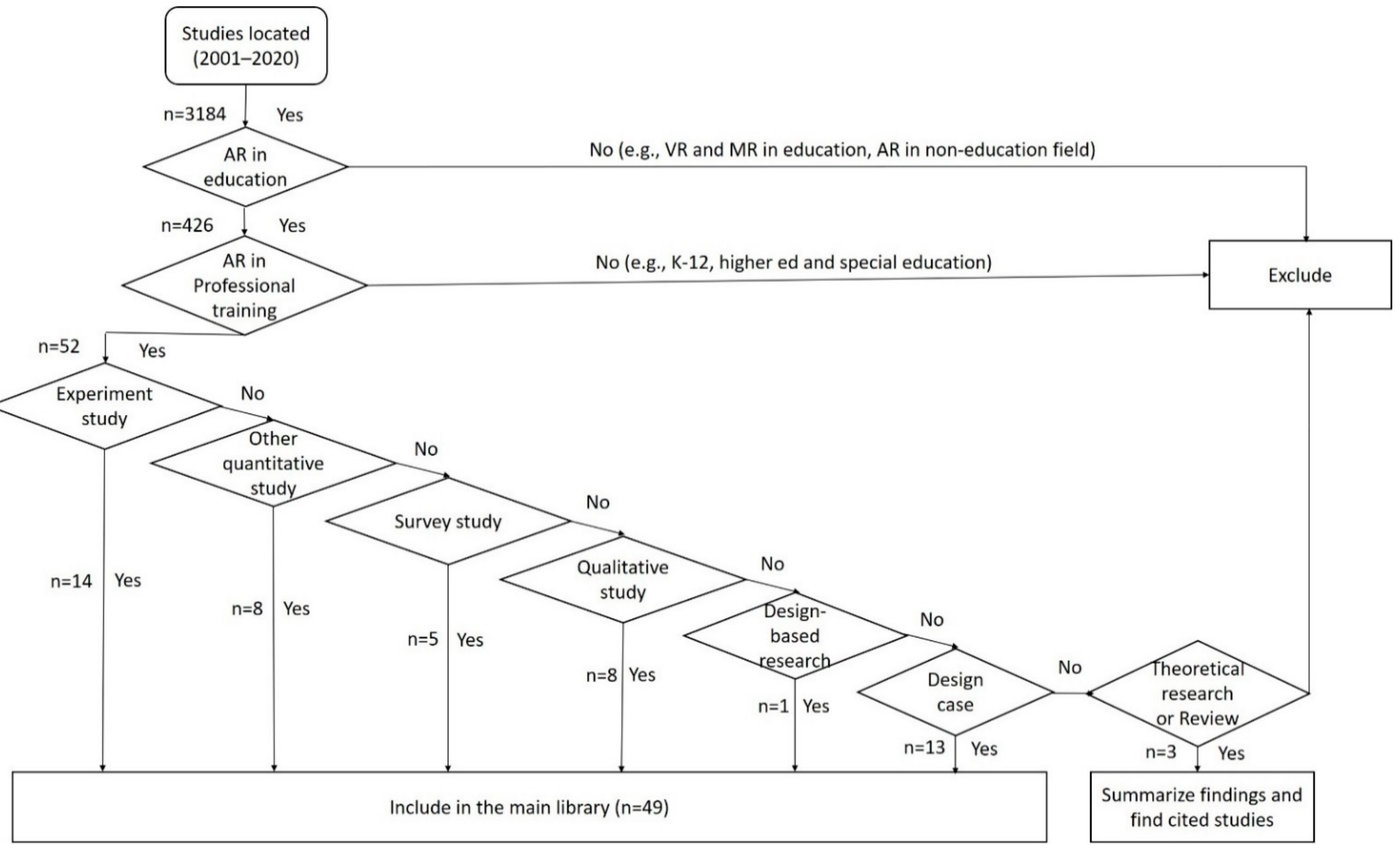
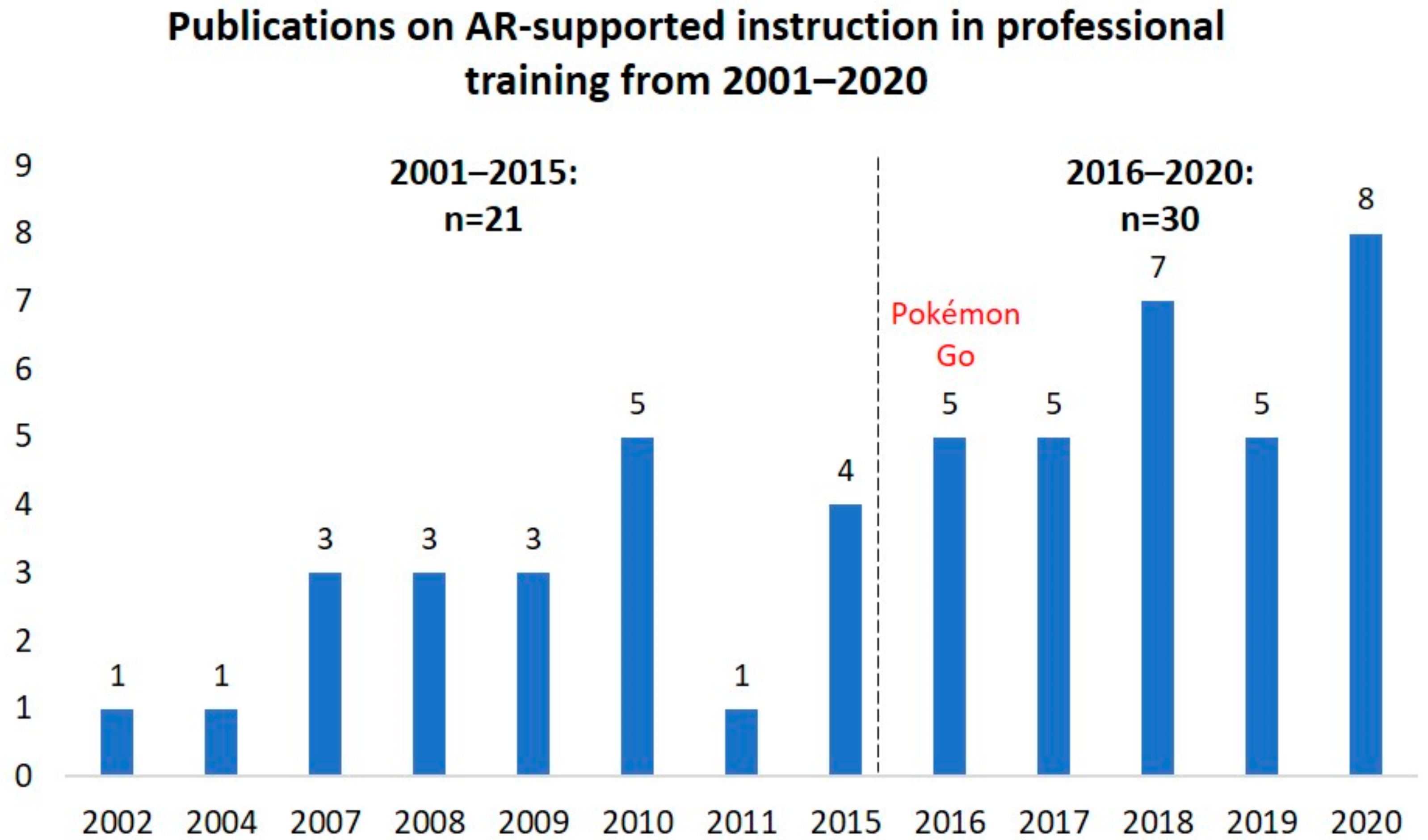
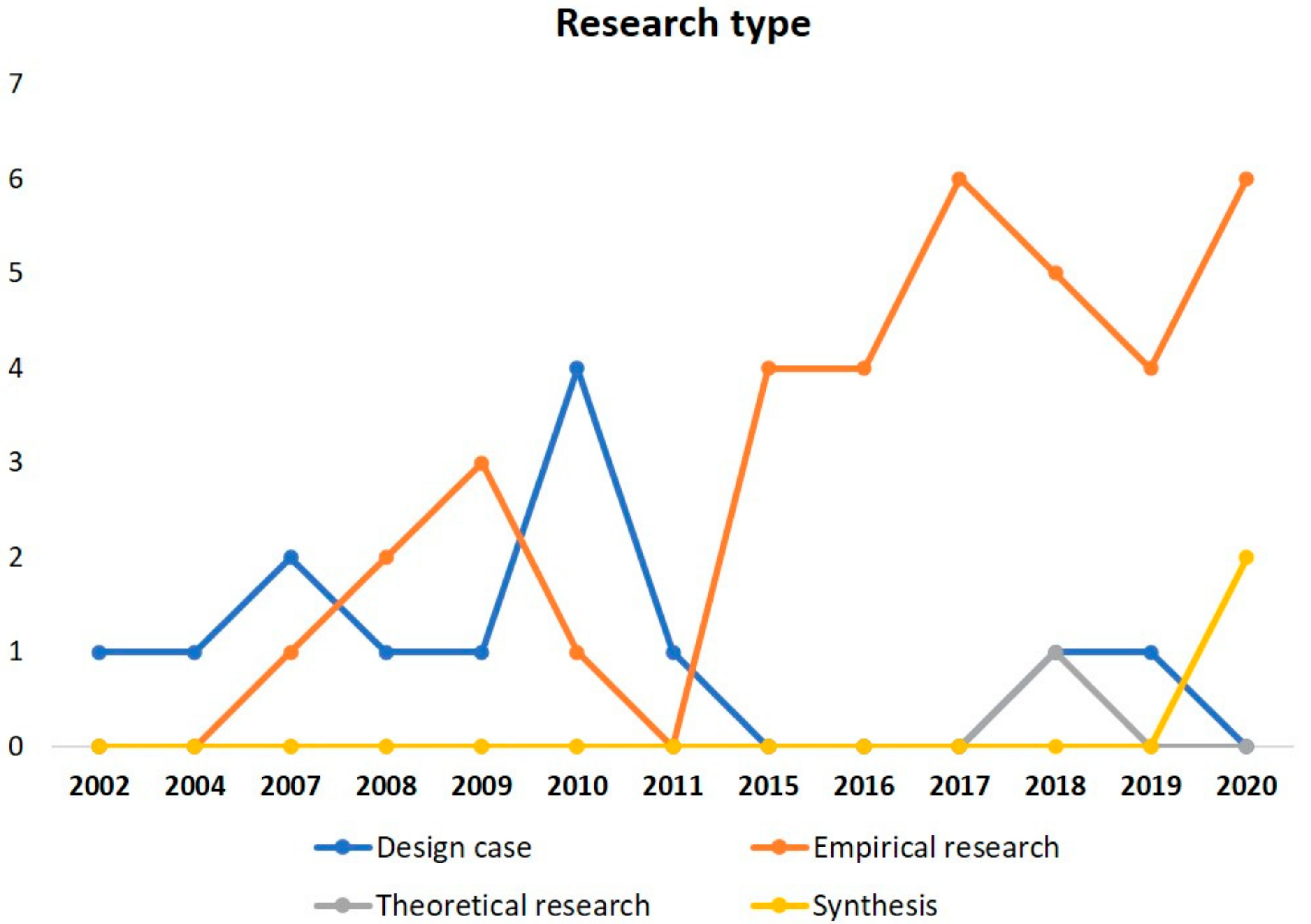
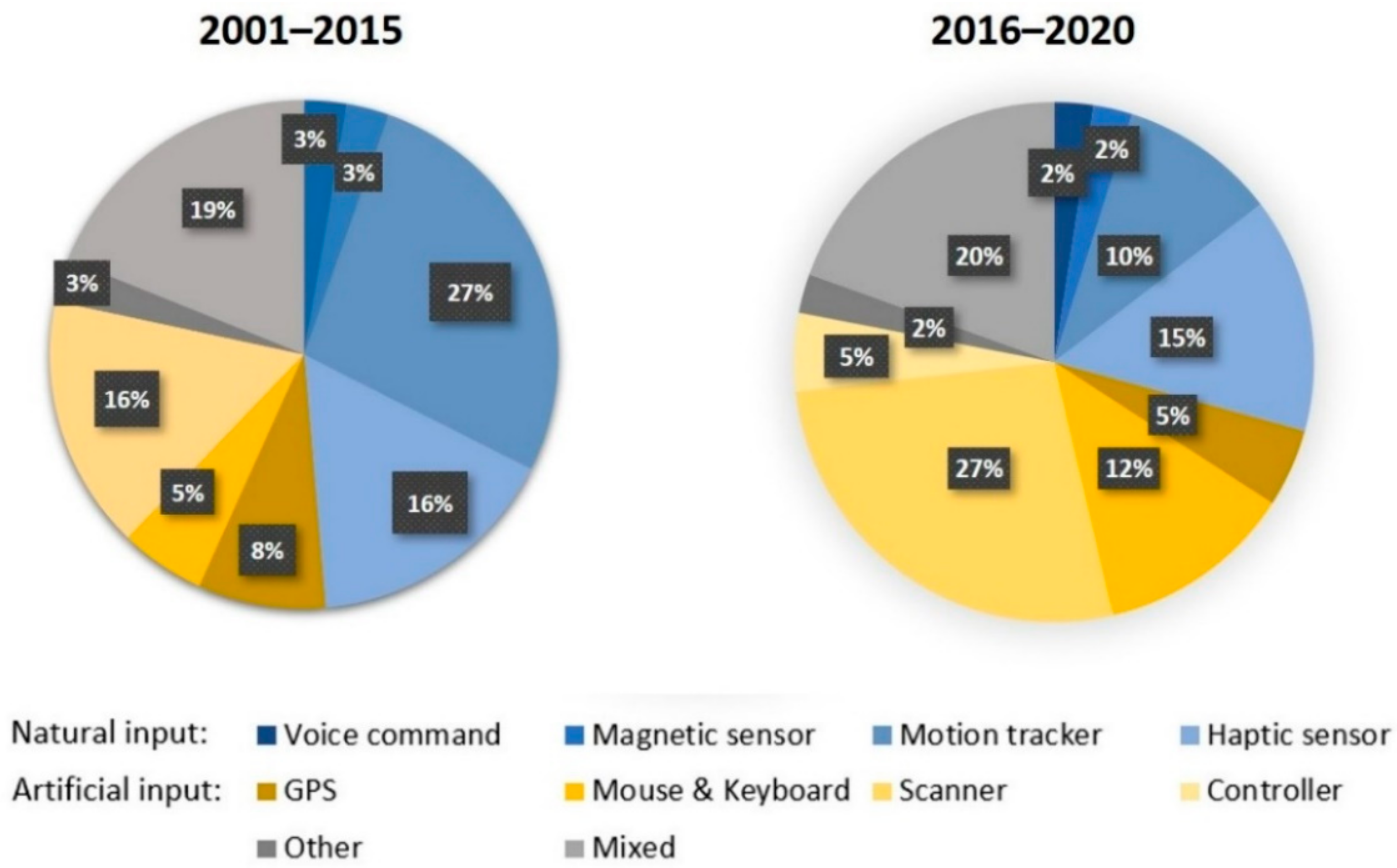
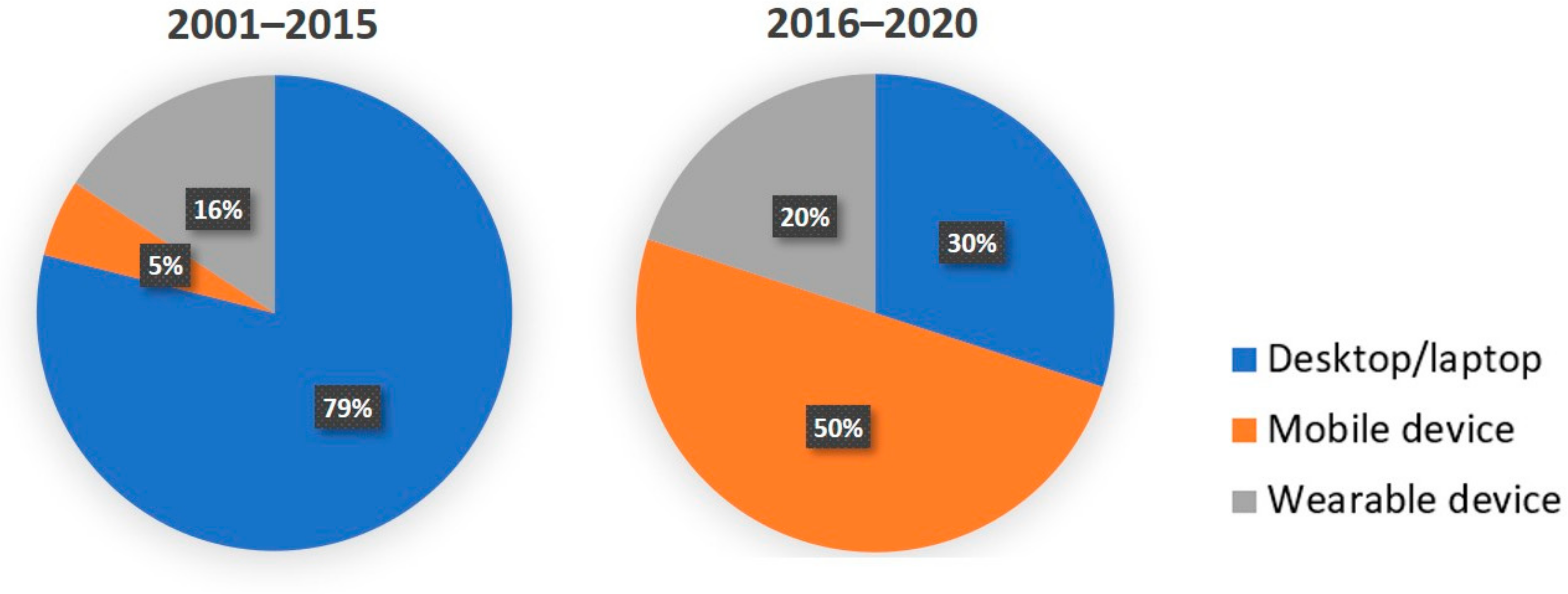
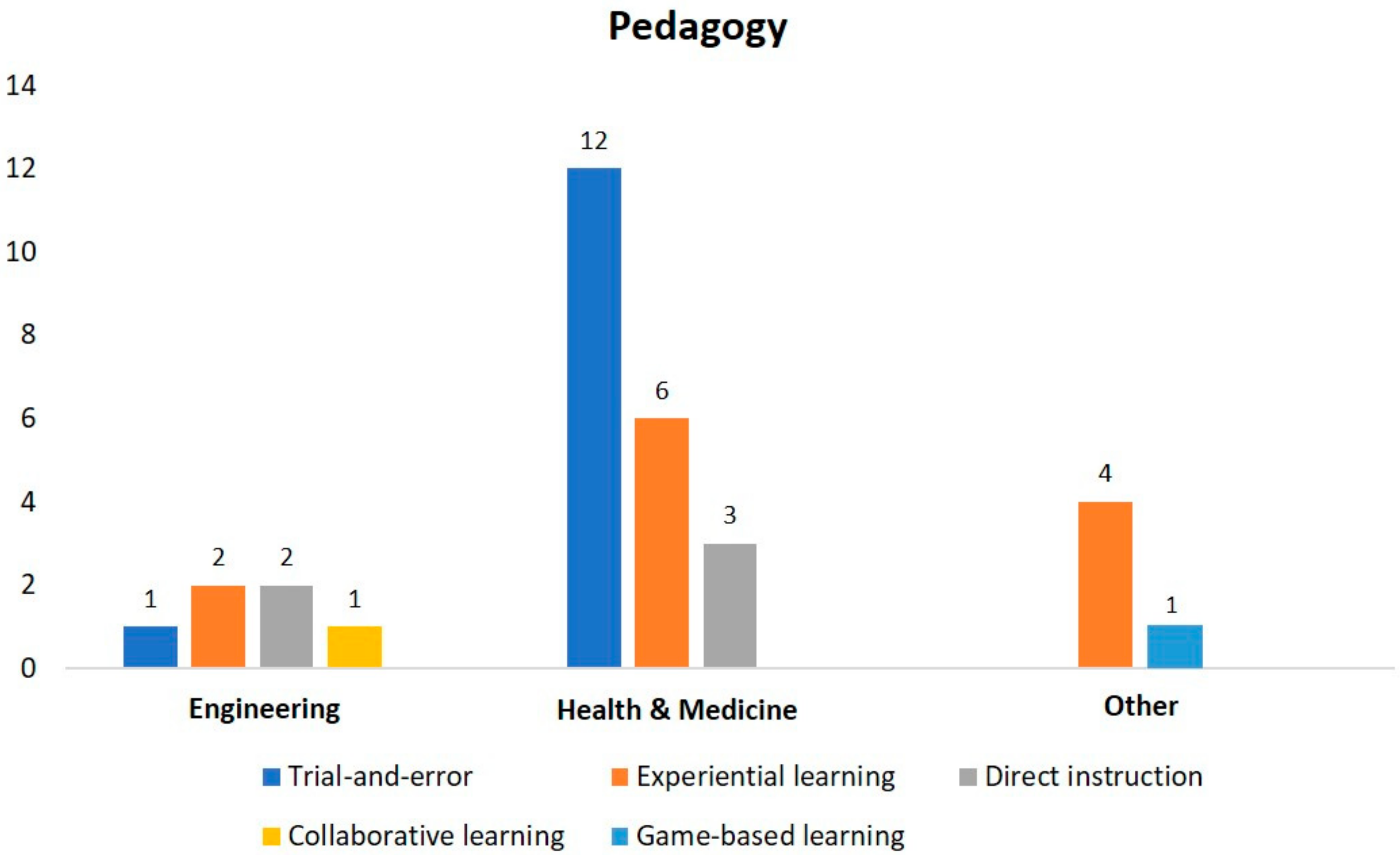
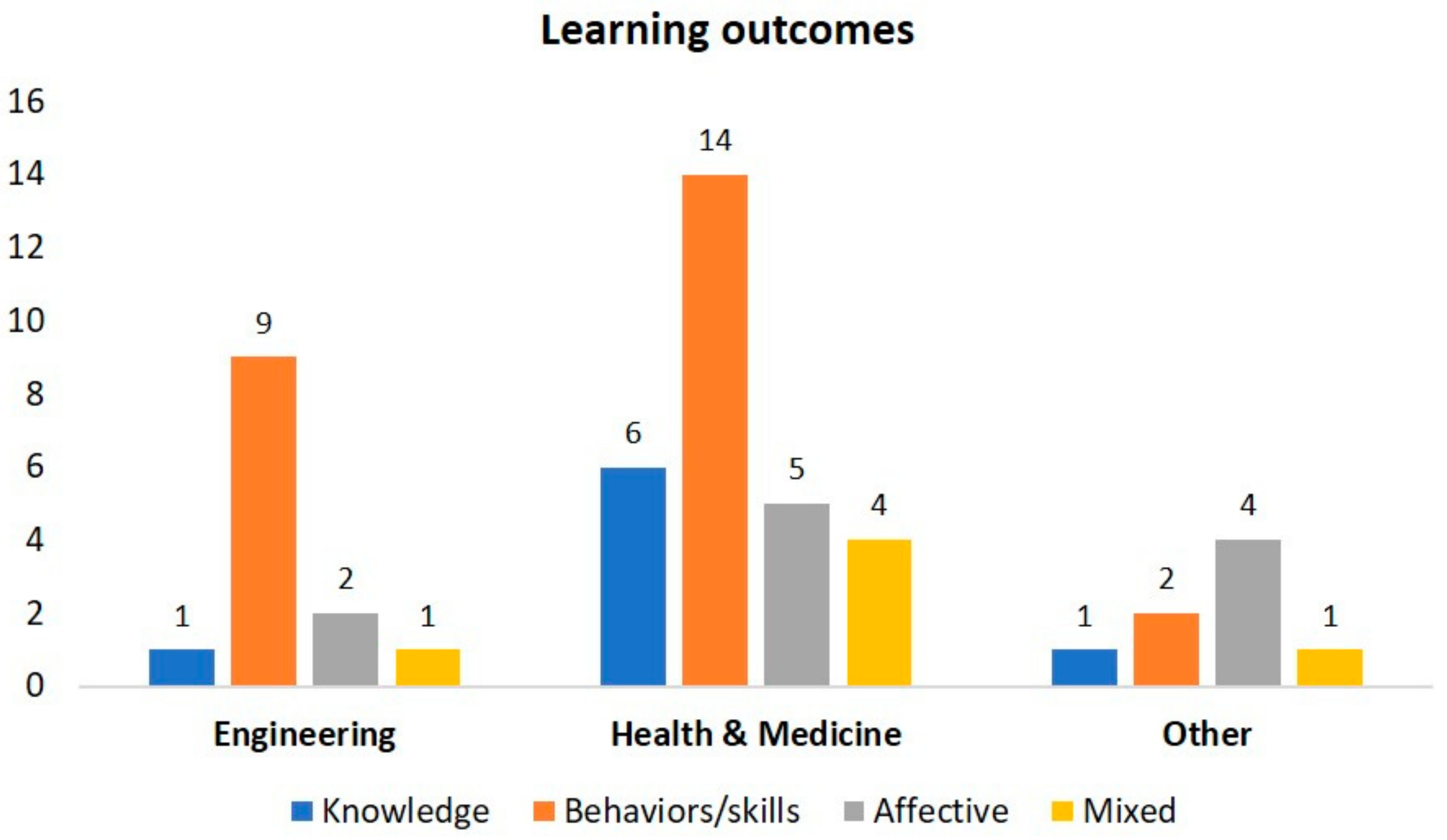
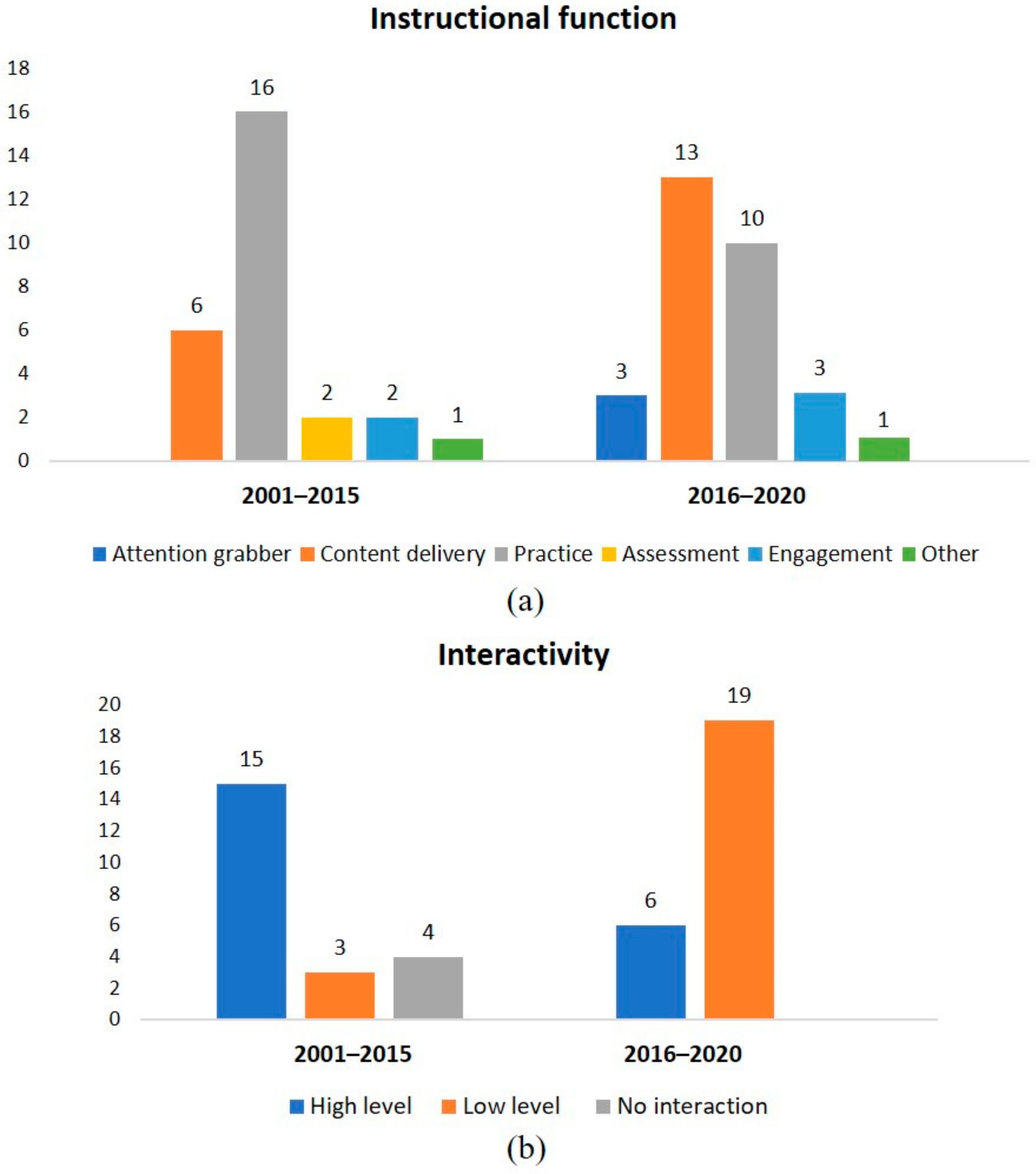
| Category | Code | Description |
|---|---|---|
| Basic information | Title | Full title of the study |
| Authors | Complete list of author names | |
| Year | Publication year | |
| Source | Information about the journal/book/URL | |
| Research type | Empirical/theoretical/synthesis | |
| Instructional context | Disciplines | Engineering/health and medicine/other |
| Implementation setting | Formal/informal | |
| Technology features | Input | Voice/magnet/motion/haptic/GPS/mouse and keyboard/scanner/other |
| Output | Monitor/video | |
| Computing devices | Desktop/laptop/mobile device/wearable device | |
| Media representation | Symbol/indicator/text/data/2D image/3D object/video/animation | |
| Interactivity | High level/low level/no interaction | |
| Instructional design | Instructional function | Attention grabber/content delivery/practice/assessment/engagement/other |
| Pedagogy | Game-based learning/trial-and-error/direct direction/experiential learning | |
| Scaffolding | No scaffolding/manual/computer | |
| Research results | Learning outcomes | Knowledge/behavior/skill/affective |
| Data source | Content Tests/surveys/interviews/videos/fieldnotes/other | |
| Statistical Results | Difference (t-test/ANOVA/MANOVA/ANCOVA/non-parametric), associational (SEM/regression/factor analysis), meta-analysis | |
| Effect size | Record if mentioned |
| Symbol/ Indicator | Text | Data | 2D Image | 3D Object | Video | Animation | Mixed | Total | |
|---|---|---|---|---|---|---|---|---|---|
| >Engineering | 1 | 4 | 0 | 3 | 8 | 5 | 4 | 4 | 29 |
| Health and medicine | 2 | 3 | 3 | 4 | 16 | 6 | 2 | 8 | 44 |
| Other | 1 | 4 | 0 | 2 | 3 | 1 | 0 | 4 | 15 |
| Total | 4 | 11 | 3 | 9 | 27 | 12 | 6 | 16 | 88 |
| Moderator | K | g | 95% CI | QB | p-Value |
|---|---|---|---|---|---|
| Discipline | 6.43 ** | 0.009 | |||
| Engineering | 3 | 1.748 | [0.421, 3.075] | ||
| Health and medicine | 11 | −0.246 | [−0.932, 0.441] | ||
| Pedagogy | 6.843 ** | 0.009 | |||
| Mixed | 3 | 1.748 | [0.421, 3.075] | ||
| Trial-and-error | 11 | −0.246 | [−0.932, 0.441] | ||
| Instructional function | 13.555 ** | 0.001 | |||
| Content delivery | 2 | 1.204 | [0.625, 1.783] | ||
| Mixed | 3 | 1.748 | [0.421, 3.075] | ||
| Practice | 10 | −0.359 | [−1.082, 0.364] | ||
| Scaffolding | 2.551 | 0.279 | |||
| No scaffolding | 8 | 0.346 | [−0.876, 1.568] | ||
| Computer | 3 | 0.520 | [−0.120, 1.160] | ||
| Manual | 4 | −0.079 | [−0.485, 0.327] | ||
| Input | 12.080 ** | 0.007 | |||
| Controller | 4 | −0.996 | [−2.557, 0.564] | ||
| Scanner | 3 | 1.748 | [0.421, 3.075] | ||
| Haptic sensor Mixed | 4 4 | 0.749 −0.0749 | [0.104, 1.395] [−0.485, 0.327] | ||
| Computing devices | 11.721 ** | 0.003 | |||
| Desktop/laptop | 8 | −0.547 | [−1.414, 0.320] | ||
| Mobile devices | 4 | 1.666 | [0.742, 2.590] | ||
| Not mentioned | 3 | 0.520 | [−0.120, 1.160] | ||
| Output | 14.609 ** | 0.001 | |||
| Monitor-based | 7 | −0.755 | [−1.636, 0.126] | ||
| Video see-through | 5 | 1.506 | [0.752, 2.259] | ||
| Not mentioned | 3 | 0.520 | [−0.120, 1.160] | ||
| Media representation | 19.417 *** | 0.000 | |||
| 3D object | 6 | −0.539 | [−1.640, 0.562] | ||
| Text | 3 | 1.748 | [0.421, 3.075] | ||
| Video | 4 | −0.079 | [−0.485, 0.327] | ||
| Mixed | 2 | 1.204 | [0.625, 1.783] |
Publisher’s Note: MDPI stays neutral with regard to jurisdictional claims in published maps and institutional affiliations. |
© 2022 by the authors. Licensee MDPI, Basel, Switzerland. This article is an open access article distributed under the terms and conditions of the Creative Commons Attribution (CC BY) license (https://creativecommons.org/licenses/by/4.0/).
Share and Cite
Han, X.; Chen, Y.; Feng, Q.; Luo, H. Augmented Reality in Professional Training: A Review of the Literature from 2001 to 2020. Appl. Sci. 2022, 12, 1024. https://doi.org/10.3390/app12031024
Han X, Chen Y, Feng Q, Luo H. Augmented Reality in Professional Training: A Review of the Literature from 2001 to 2020. Applied Sciences. 2022; 12(3):1024. https://doi.org/10.3390/app12031024
Chicago/Turabian StyleHan, Xu, Ying Chen, Qinna Feng, and Heng Luo. 2022. "Augmented Reality in Professional Training: A Review of the Literature from 2001 to 2020" Applied Sciences 12, no. 3: 1024. https://doi.org/10.3390/app12031024
APA StyleHan, X., Chen, Y., Feng, Q., & Luo, H. (2022). Augmented Reality in Professional Training: A Review of the Literature from 2001 to 2020. Applied Sciences, 12(3), 1024. https://doi.org/10.3390/app12031024







